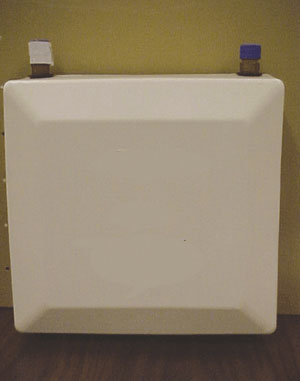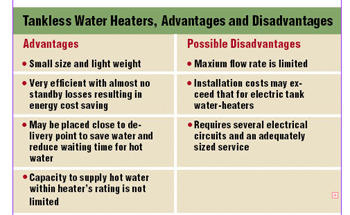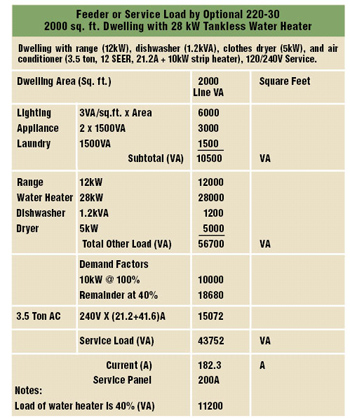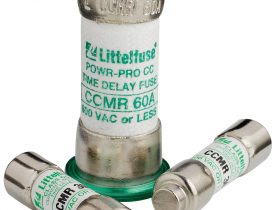A recent study by the National Association of Home Builders (NAHB) Research Center concluded that the national average for hot water usage in homes is approximately 62 gallons per day or 22,630 gallons per year.1 To heat all of this water, there are many choices in water-heating systems. All such systems serve to raise the temperature of the incoming water to about 120°F (49°C) at the hot water outlets. The heart of the system is the water-heating unit that may be gas fired, electric, solar, or energized by other means.
This article specifically concentrates on the increasingly popular water heaters variously known as on-demand, instantaneous, or tankless water heaters. Further, only electric units are considered although gas-fired units are available. After defining these water heaters, their applications and performance specifications are covered. Then, they are compared to the conventional tank-type water heaters in terms of the advantages and disadvantages. Finally, the article describes the electrical requirements and the National Electrical Code rules that apply to these tankless water heaters.

Definition
As an alternative or booster unit to a tank-type water heater, a number of products for heating water have been developed that respond only when hot water is demanded from a tap. Although these so-called instantaneous or tankless water heaters are not exactly either instantaneous or tankless, such names are frequently applied to these units and will be used in this article. These heaters are termed tankless because they are characterized by a very small storage capacity, usually less than a gallon of water. Their capability to heat the water to temperature very rapidly, within a few seconds to 30 seconds when it is flowing, leads to the description instantaneous.
The tankless water-heaters can be characterized by their intended application. Units that serve only one tap or faucet are called point-of-use heaters. Point-of-use heaters are popular in Europe and Asia. More powerful units that can serve the hot water needs of a home are called whole-house tankless heaters. This article mainly considers tankless, whole-house electric water-heaters as installed in the U.S. and in Canada. The heaters use resistive heating elements in the water flow chambers to heat the water. Photo 1 shows a tankless water heater that is suitable for whole house applications. The unit is about the size of a large briefcase and weighs just over 20 pounds. Cold water enters from the right-hand inlet and the heated water flows out of the connection on the left. The circuit hookup is not shown.
Applications
Tankless water heaters are used in various applications where hot water is used for domestic purposes, such as washing and showering, and also in space heating installations. For some homes, a tankless water heater of the proper capacity could serve all of the domestic hot-water needs. Other home installations with heavy hot-water demand might require several such heaters or a combination of a tankless and tank heater. Another design of a hot-water system is to combine a solar system with a tankless heater to assure the availability of hot water when solar energy is not available to heat water.
Space heating applications for which tankless water heaters are ideal involve using hot water in a recirculating system to heat rooms in a house. The heat may be transferred from underfloor pipes through which the hot water flows or from baseboard heat exchangers.
Many commercial establishments have installed tankless water heaters for utility and energy savings. Convenience stores, fast food chains, and hair salons are typical locations that might benefit from a tankless water heater.
Vacation homes are good locations to use a tankless water heater since the heater draws no current to heat water unless hot water is needed. If the home is used only periodically, the tankless heater is a good choice to save on energy costs but have hot water available as soon as the occupants arrive.
Performance
For a tankless water heater supplying domestic hot water, two specifications are required to properly determine the rating of a heater that would be adequate. The first is the temperature rise necessary based on the inlet water temperature expected. The second specification is the flow rate in gallons per minute (GPM) expected for the hot water.
As an example, if the inlet water at its coldest is 57°F (13.9°C) and the desired hot water temperature is to be 120°F (48.9°C), the heater must provide a 63°F (35°C) rise. The actual flow rate can vary significantly depending on the number of hot water faucets open at one time. A nominal value for hot water flow in a home with average water use might be 3 GPM. However, fixtures as in showers with multiple showerheads or whirlpool baths may require considerably more flow of hot water.
The main concern for a builder, installer, or inspector should be that the heater rating and the circuits and service supply be adequate for the installation. The necessary circuit and service rating are treated later in this article. Since the tankless water heaters have practically no storage capacity and they only heat water after flow is detected, the heating elements must be sized to meet the maximum expected water flow demand of the house.
The tankless water heaters are often specified by their BTU ratings and by listing the temperature rise expected for a steady flow rate of water. As an example, the specification for one water heater indicates that the heater is capable of raising the input water temperature 63°F (35°C) at a steady flow rate of 3.0 GPM (3.78 liters/min). The electrical energy required to supply this heater is given by this energy plus the energy lost by the heater. Since tankless heaters are often 95 percent or more efficient, the heating losses can usually be neglected.
As calculated in the appendix to this article, a power input of about 28 kW is necessary to heat the water flowing at 3 GPM to 120°F. One model of heater has four 7000-watt elements and can thus produce 28,000 watts at 240 volts for whole-house hot water heating. This heater would require 117 amperes when operating at full power.
The whole-house tankless water heaters are available with electrical ratings from about 18 kW to 30 kW, although smaller and larger rated units are available for special applications.
Advantages and Disadvantages
Electric tank water heaters are rated for storage capacity, efficiency, and electrical demand. Typical home-use tanks hold 30 to 100 gallons of water and thus are large and are usually placed in an area such as the garage. Electric power requirements are determined by the rating of the heating element but a typical tank heater could use a 5000-watt element supplied by a 30-ampere, 240-volt circuit. The efficiency of converting electrical energy to energy in the water varies from about 60 percent but may be as high as 75 percent or higher depending on the insulation for the tank. If the tank heater is powered continuously but hot water is not used, a certain amount of standby loss in energy is unavoidable. Also, if the total hot water supply in the tank is exhausted, many minutes of recovery time is required before hot water can be supplied again.
In comparison with tank heaters, the tankless heater may have a number of advantages and disadvantages as summarized in table 1. The tankless model described is a 28 kW version designed to supply household hot water for a house of perhaps 2000 to 3000 sq. ft. in area with two bathrooms.
The 28 kW model of tankless heater as shown in photo 1 is about 40 x 40 x 16 cm (16 x 16 x 6-1/4 in.) and weighs only 10.5 kg (23 lbs). This size and weight allows easy plumbing installation at any convenient location within a home or business.
Studies have shown that a tankless water heater is highly efficient and has practically no standby losses.1 This can save a considerable amount of electrical energy compared to an equivalent tank heater, particularly if the residents use little water compared to the average household users since the standby losses of a tank become more significant compared to the energy used to heat the lesser amount of water demanded at the faucets.
A common complaint of homeowners is that it takes too much time before hot water reaches the faucets or showerhead in a bathroom. The wait can be several minutes or more. Obviously, the unheated water must be purged from the hot water pipe leading to the taps before hot water is available. This is not only an irritation for the user but also wastes water. One solution is to place a tankless water heater centrally in a home so that the piping distance for hot water to the taps is minimized. Alternatively in a larger home, the tankless water heater can be used as booster unit in series with a tank heater. If the tankless heater is placed close to the taps, it supplies hot water almost immediately and then only raises the temperature of the water from the tank heater to overcome losses in the piping when hot water arrives from the tank.

Perhaps the biggest advantage of a tankless water heater is that there is no theoretical limit to the amount of hot water that can be produced within the flow rate capacity of the heater. For those desiring to take very long showers, the tankless water heater is ideal.
Although the amount of hot water is “limitless,” the flow rate that can be sustained for water at the desired temperature is limited. Many units advertised as whole-house units will provide up to 2–3 GPM of hot water with a 60 to 70°F temperature rise. This should be sufficient for the hot water requirements of one shower and a sink simultaneously. If the heater is operating at full power and a higher flow rate is demanded, by opening another faucet for example, the outlet temperature at the heater will decrease. The NAHB report cited earlier indicates that there are relatively few times that a tankless heater of suitable rating cannot meet the demand for hot water.1
Obviously it is difficult to estimate prices for the purchase and installation of a tankless water heater versus that for a tank heater. The overall initial investment depends on the heater price and the installation costs. However, the initial price and the cost of the electrical circuits are generally higher for the tankless water heater. Savings in energy costs may offset this higher initial cost over time.
Because of the electrical demand of a whole-house tankless water heater, some installations may cause annoying light flicker due to the changing voltage drop when the heater cycles between power levels. In the author’s experience, the problem is usually caused by an inadequately sized utility transformer or an undersized service.

Electrical Requirements for Tankless Water Heaters
Tankless water heaters are referred to as instantaneous water heaters in the NEC. Article 422 covers these heaters used for domestic water heating. In particular, 422.11(F)(3) allows listed instantaneous water heaters to be supplied by circuits not exceeding 120 amperes and protected at not more than 150 amperes.2
Assuming a 240-volt, single-phase utility system, a 28-kW tankless water heater would require branch circuits supplying 117 amperes. A four-element heater with 7000-watt elements could thus be supplied by four 30-ampere circuits or two 60-ampere circuits, or one 120-ampere circuit according to the NEC. Figure 1 shows a simplified diagram of the four circuits required for a 28-kW heater.

In a space-heating application, the branch-circuit conductors and overcurrent devices are required to be rated at 125 percent of the total heater ampere load according to 424.3(B).
Table 2 shows a sample load calculation for a 2000 sq. ft. home with a 28-kW tankless water heater. Using NEC 220.30 for optional feeder and service calculations for a dwelling unit, the service requirement is 200 amperes.
Various Rules and Inspection
A number of standards and codes that cover water heaters are concerned with hazards due to the buildup of excessive temperature or pressure. For example, Underwriters Laboratories UL 499 applies to electric heating appliances. That document and NEC 422.47 requires most water heaters to have a temperature and pressure-relief device. However, tankless or instantaneous heaters are exempt from that requirement. UL 499 only requires the valve for pressure vessels of more than 3.0 inches in inside diameter used in heaters. Since the heaters discussed in this article would not have heating chambers that large, no pressure relief valve is necessary. NEC 422.47 exempts instantaneous-type water with a capacity of 4 liters (1 gallon) or less.
When water heaters are installed in manufactured homes, various rules apply as defined in Part 3280—Manufactured Home Construction and Safety Standards, issued by the U.S. Department of Housing and Urban Development. Also, NFPA 501 covers manufactured housing.
Conclusions
A tankless water heater can serve as an alternative to a tank-type heater for domestic water heating or as a substitute for a boiler in a space heating application. For further information about tankless water heaters, see the various web sites that compare the commercially available water heaters.3
1 “Performance Comparison of Residential Hot Water Systems,” NAHB Research Center, Inc., Upper Marlboro, MD, November 2002.
2 Other electric heating appliances with resistance-type heating elements must have their heating elements subdivided to not exceed 48 amperes and be protected at not more than 60 amperes. According to 422.13, a storage-type water heater requires a branch-circuit rating of not less than 125 percent of the nameplate rating of the heater.
3 For example, visit the sitehttp://www.eere.energy.gov/consumerinfo and search for “tankless.” This is a U.S. Department of Energy site.











Find Us on Socials